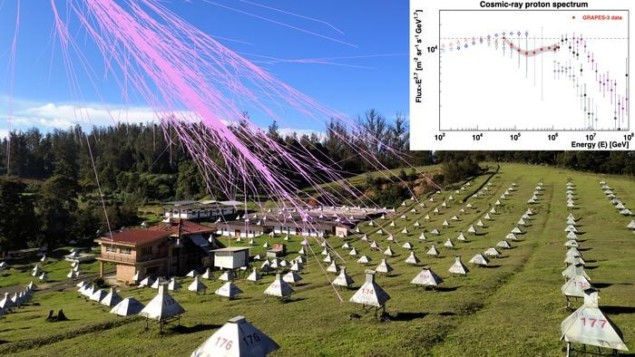
Using observations from the GRAPES-3 muon detector, physicists in India and Japan have explored a poorly understood region of the cosmic ray energy spectrum in unprecedented detail. Fahim Varsi at the Indian Institute of Technology Kanpur and colleagues identified a previously unseen feature in the form of a kink in the spectrum. The observations suggest a need to rethink the origins of cosmic rays.
Composed mainly of protons and helium nuclei, cosmic rays are highly energetic particles that constantly bombard Earth’s atmosphere. As they interact with the atmosphere, cosmic rays produce showers of secondary particles, including electrons, photons, and muons – which rain down on Earth.
Cosmic rays were first identified in 1912, in Nobel Prize-winning observations done by Victor Hess. Yet even over a century after their initial detection, we still have much to learn about the nature of these particles. While astronomers believe that cosmic rays originate from a number of different sources including stars, supernovae and active galactic nuclei, their origins are not fully understood because the particles are deflected by magnetic fields as they travel great distances to Earth.
Precise measurements required
“Cosmic rays are known to be the most energetic particles in the universe,” says team member Pravata Mohanty at the Tata Institute for Fundamental Research in Mumbai. “Precise measurement of the shape of the elemental energy spectrum in cosmic rays is required to advance our understanding of their origins, acceleration, and propagation.”
One particularly glaring gap in understanding lies in the middle of the cosmic-ray spectrum at energies in the 100 TeV–1 PeV range. In this window, the particles are too energetic to be picked up directly by space-based detectors, but not energetic enough for large numbers of shower particles to reach detectors on Earth.
To explore this energy range in more detail, Varsi’s team examined observations from the GRAPES-3 experiment. This is a muon observatory located in the south of India that comprises an array of scintillating detectors. The facility sits at 2200 m above sea level, making it easier to detect muons before they interact with the atmosphere.
“GRAPES-3 contains a large area detector, enabling us to measure the elemental composition of cosmic rays through the muon component in cosmic ray showers,” Mohanty explains. “With a detection area several thousand times larger than the space-based detectors, GRAPES-3 ensures exceptionally high statistical precision in measurements.”
Four-year study
The researchers evaluated about 8 million shower events observed across a 460-day period in 2014 and 2015. Owing to the complexity of their analytical and error correction techniques, the analysis took four years to complete. The team says its results provide the first detailed view of the mid-energy window.
“The study measured the proton spectrum in cosmic-rays from 50 TeV to 1.3 PeV, effectively connecting observations from both space-based and ground-based measurements,” Mohanty describes.
Among the most striking features spotted by Varsi’s team was a kink in the energy spectrum at around 166 TeV, with more cosmic protons than expected detected at slightly higher energies. Previously, ground-based experiments had detected a similar kink at around 3 PeV, which was thought to be the maximum energy for cosmic rays originating from galaxies.
Up to this point, researchers had generally assumed that the proton energy spectrum in the observed region can be described by a simple power law. However, the team’s discovery appears to shatter this assumption.
“It suggests the possibility that one class of sources, commonly believed to be supernova remnants, may effectively accelerate cosmic rays up to the observed kink, while another class becomes predominant beyond the kink,” Mohanty explains.
By building on these results, Varsi’s team hope that new models could soon emerge to account for these effects. If achieved, they could help to strengthen our understanding of how cosmic rays emerge, accelerate, and propagate across intergalactic distances.
The research is described in Physical Review Letters.
- SEO Powered Content & PR Distribution. Get Amplified Today.
- PlatoData.Network Vertical Generative Ai. Empower Yourself. Access Here.
- PlatoAiStream. Web3 Intelligence. Knowledge Amplified. Access Here.
- PlatoESG. Carbon, CleanTech, Energy, Environment, Solar, Waste Management. Access Here.
- PlatoHealth. Biotech and Clinical Trials Intelligence. Access Here.
- Source: https://physicsworld.com/a/kink-in-cosmic-ray-spectrum-puzzles-astrophysicists/



